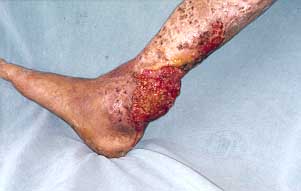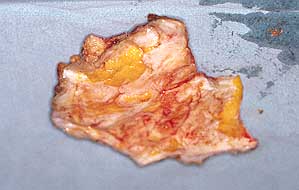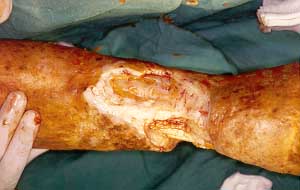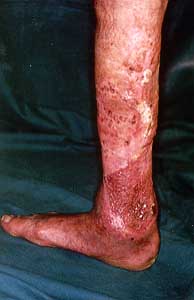Annals qf Burns and Fire Disasters - vol. XI - n. 4 - December 1998 BURN SCARS COMPLICATED BY VERRUCOUS CARCINOMA. OUR EXPERIENCE Brienza E.,* Albanese V.,** Armenise G.,** Miro A.** Divisione di
Chirurgia Plastica A.O. V. Fazzi, Lecce, ltaly SUMMARY. A report is presented on the surgical treatment of post-burn sequelae complicated by a histologically defined verrucous carcinoma. After destructive plastic surgery, reconstruction proved to be partially unsuccessful in all the patients treated, owing to recidivation. The lesions were healed by the use of simple topical treatment with creams enriched with proteolytic enzymes, without any further histological evidence of neoplasia. The methods of treatment and application are described. Introduction Spinocellular carcinoma (Marjolin's ulcer) is frequently observed in post-burn scar tissue areas. However, the lesions rarely develop into histological forms of verrucous carcinoma.This observation, which is confirmed by the limited number of cases reported in the literature, stimulated our interest because in cases that have been histologically diagnosed local recidivation has been observed following surgical removal.It has been found possible to cure these lesions with a series of simple topical treatments using proteolytic enzymes. The results were confirmed histologically.These findings have to be considered in relatioq to the particular structural characteristics of the lesion and the as yet not fully understood chronological penetration of the neoplasia. Verrucous carcinomaVerrucous carcinoma, an epithelial tumour, is a rare variant of the well-differentiated squamous cell carcinoma.It is known by different names, depending on the site of onset: Ackerman's turnour (of the oral and laryngeal cavity), Bushke-Loewenstein's tumour or giant condyloma of the penis, oral florid papillomatosis, epithelioma or cuniculate carcinoma, and Gottron's cutaneous carcinoid papillomatosis.The oncogenetic mechanism is unknown. The histological and viral characteristics are similar to those of common warts and condylomas.Some researchers` believe that verrucous carcinoma is more akin to common warts and condylomas than to the typical squamous cell carcinoma, from which it differs in two ways: the presence of epithelial phytons consisting of squamous epithelium lacking any cellularabnormalities, and the almost total absence of metastasis. Confirming the imprecise oncological identity, recent studies have discovered in the cells of this neoplasia an abnormal production of the tumour- suppressing protein p 53 and impaired regulation of proline-rich proteins, which are precursors of the development of comification. Materials and methods In the last two years seven cases of verrucous carcinoma have been selected and observed in our Department. The following criteria were followed:
All the patients were male and aged between 65 and 75 years. Ample surgical exeresis of the lesion was followed by histological examination confirming the histological tests. After lost body mass had been reconstructed by grafts, it was found between 8 and 15 days after surgery that the grafts had taken only partially, owing to evident recidivation of the neoplasia. This was probably due to insufficient depth of enucleation as a consequence of this type of neoplasia's characteristic feature of local penetration. It was decided to follow a protocol of daily dressings with collagenase (clostridipeptidase A) 60 units + CAF 1 g per 100 g product for the first 10 days and clostridipeptidase A 1.2 units + protease 0.24 units (according to Kunitz) per g of product for a further two weeks. On termination of treatment, serial biopsies were performed on the scar area of the lesion. No sign of, verrucous carcinoma was found.
Conclusions The incomplete
documentation in the literature on the oncogenetic mechanism of verrucous carcinoma
prevents us from advancing any confident therapeutic hypothesis for the solution of this
condition when it develops in burn scars. Destructive surgical treatment has been observed
to be followed by recidivation, which has nullified the results. However, topical
treatment with proteolytic enzymes was found to lead to complete remission of the
neoplasia, with healing of the lesion. Our hypothesis - still to be confirmed - is that
the proteolytic mechanism of the collagenase applied to the lesions may have interfered
with vital replicative activity.
RESUME. Les Auteurs décrivent leurs expériences avec le traitement chirurgical des séquelles cicatricielles des brûlures compliquées par le carcinome verruqueux histologiquement défini. Ils ont observé que, à la suite de l'opération chirurgicale dévastatrice, la reconstruction a eu des résultats insuffisants dans tous les patients traités, à cause des récidivî~_Le traitement topique avec une crème enrichie d'enzymes protéolytiques nous a permis d'obtenir la guérison des lésions, sans ultérieure évidence histologique de la néoplasie. Les méthodes et les modalités d'application sont décrites. BIBLIOGRAPHY
|



